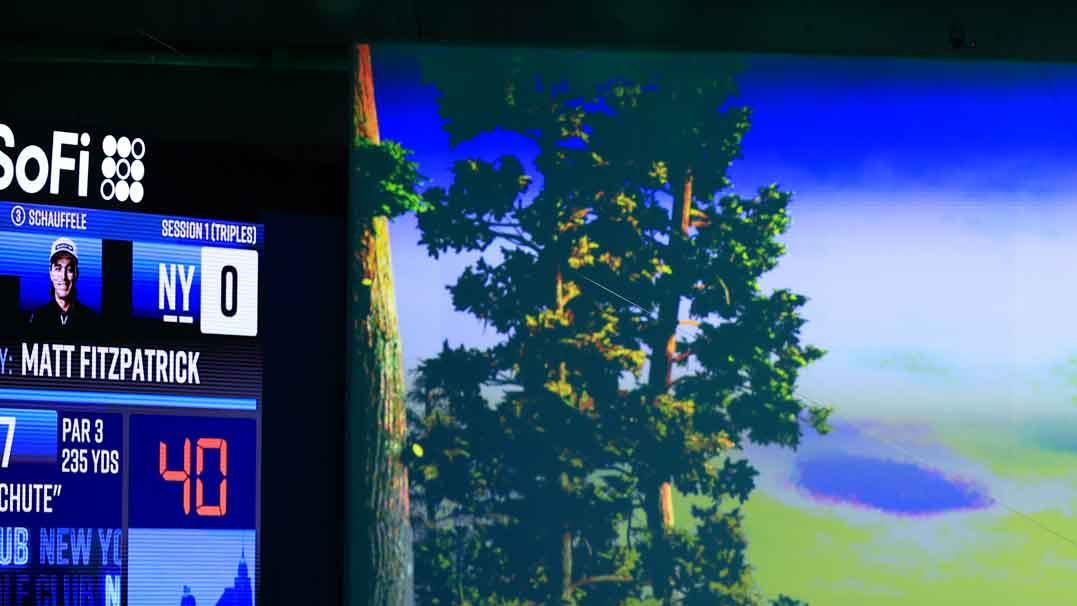By: Alan Bastable January 8, 2025

Shane Lowry on the tee in TGL’s debut match.
getty images
Phew.
That was something, right?
However you felt about the TGL’s debut match at the blinged-out SoFi Center in West Palm Beach, Fla., Tuesday evening, you likely had…thoughts.
Maybe you rolled your eyes at the voluminous WWE-grade pre-match introductions (“make some noise for Matt Fitz-PAAAA-trick!!!), which were followed by Dad-bod golfers humbly strolling into the arena in crisp white pants and polos.
Or maybe you were awed by the tens of millions of dollars’ worth of TGL technology finally seeing some competitive reps: the six-story-tall simulator screen; the wondrous rotating green with nearly 600 hydraulic jacks beneath its surface; the jumbo touch-screen yardage “book” over which teammates could strategize shots and club selections.
Maybe you cringed at the Lambo-fast downhill putts that seemed better suited for miniature golf than the professional variety. Or maybe you dug the variety of outrageous hole designs — Serpent! Oh Chute! Pick Yer Plunder! — that were a long way from anything you’ll find at TPC Craig Ranch.
Maybe you could have done without DJ Khaled’s interminably long cameo. Or maybe you appreciated ESPN’s repeated cuts to the team owners, peering down on their subjects like wealthy Romans ogling gladiators in the Colosseum.
Maybe you’re convinced TGL is everything that’s wrong with professional golf in 2024. Or maybe this brave new league fills you with hope and enthusiasm for what’s possible in the evolution of the so-called ancient game.
But let us put all that aside for a quick moment to celebrate the one thing that seemingly every player, ticket-holder, viewer, reporter, tweeter, dog, cat and goldfish rallied behind: TGL’s gloriously swift pace of play. Keeping play moving was essential not only to keep the audience engaged but also to squeeze a 15-hole match into a two-hour broadcast window, a mission TGL accomplished by not just encouraging speedy play but mandating it.
If you were watching the broadcast, you surely noted the rule: Players were allotted no more than 40 seconds to play a shot, a number derived from the USGA’s pace-of-play recommendation for traditional golf but one that also is routinely ignored in the upper echelons of pro golf, largely because slow play is not tightly policed.
At TGL, though, Keep it Moving or Else is a commandment that’s etched in stone. The specifics are right there in the official rules, which state that “each player will have 40 seconds to hit their shot, or their team will receive a shot clock violation and a one-stroke penalty.”
By: Josh Schrock
Enforcing the timing rules is TGL’s resident referee and a guy who knows a little something about shot clocks: former NBA ref Derrick Stafford. He has some help, too, by way of two can’t-miss-’em digital timers that flank either side of the sim screen. Should the players need another reminder about their dwindling time, they receive it when the clock hits the 15-second mark in the form of a heartbeat sound that pulses through the arena.
Corny? Heck, no. It’s brilliant. When one player walked off the tee, the next player was already fast-walking toward the tee box, yardage computed, club in hand. It was golf meets F1, and golf fans on social media lapped it up. Playing indoors (no wind!) and off perfect lies certainly makes club selection easier and faster, but still, in spots you could sense the guys would have liked to take a few more moments to assess their shots, especially on the greens. Professional golfers like to be on control of everything. They move at their own pace and pull the trigger only when fully committed. The shot clock can and will disrupt that sequencing — for some players, anyway.
If you take the TGL players from opening night at their word, though, none of them meet that description. Repping the Bay GC were Shane Lowry, Wyndham Clark and Ludvig Åberg who throttled their opponents, New York GC’s Xander Schauffele, Rickie Fowler and Matt Fitzpatrick, 9-2. Asked about the shot clock afterward, every player to a man praised it, with Fitzpatrick going as far to say, “I wish that was [in] real golf.”
Lowry admitted that during his Monday practice session, the clock did take some getting used to — “couldn’t believe how quickly everything happens,” he said — but added that other teams are more likely to struggle with the time pressure than his squad will.
“Our team is not going to have any trouble with that,” he said. “We’re three of the quicker players out there.”
Indeed, at no point Tuesday did either team appear stressed by their 40-second stricture. Conversely, they seemed to embrace the pace, and perhaps were even liberated by it.
Toward the end of their post-match press conference, the New York team was asked if there is a TGL rule that might make sense to apply to traditional golf.
Fitzpatrick and Fowler needed all of about half a second before they uttered the same two-word response in harmony: “Shot clock.”
But Fitzpatrick wasn’t done.
He leaned back into his mic and said, “No question.”



